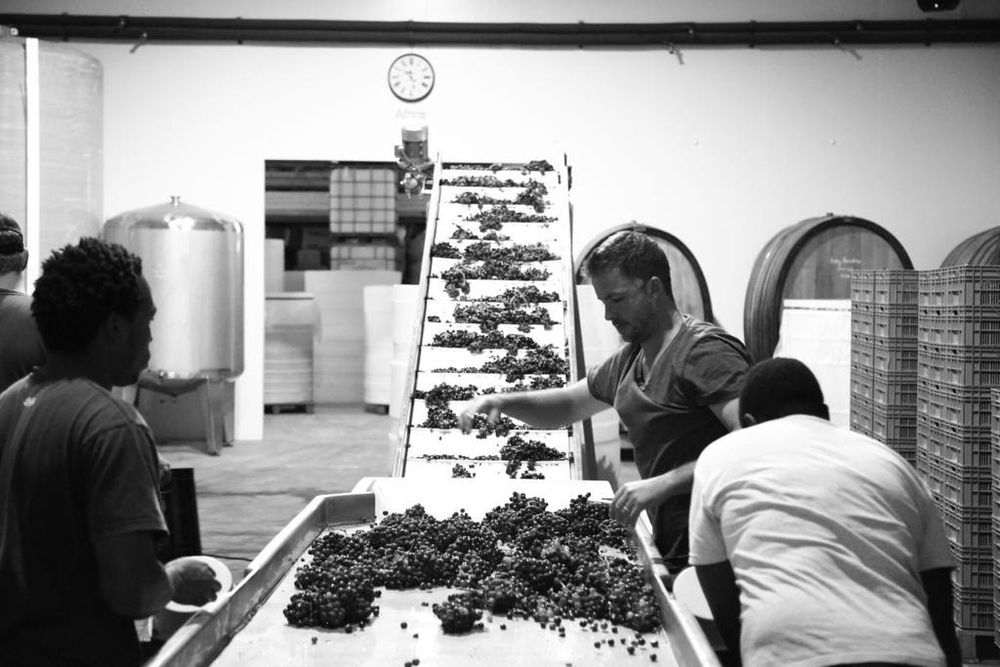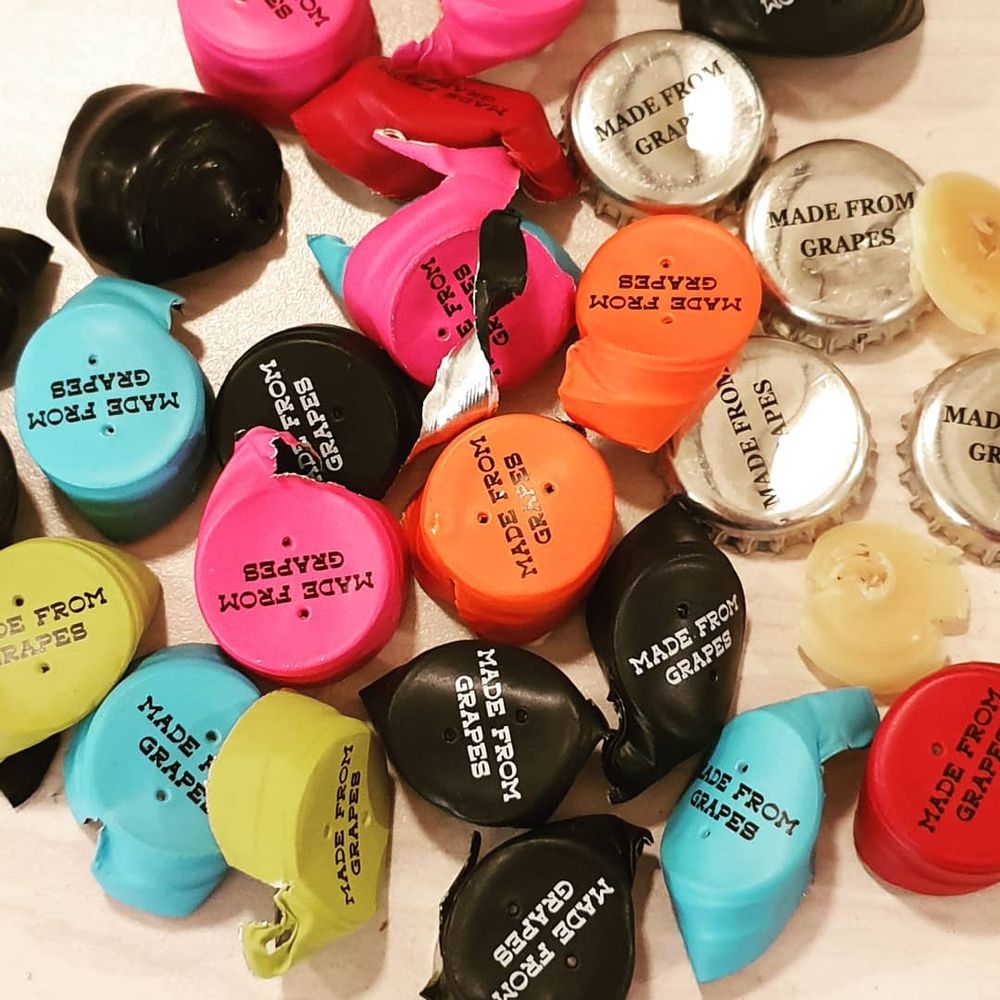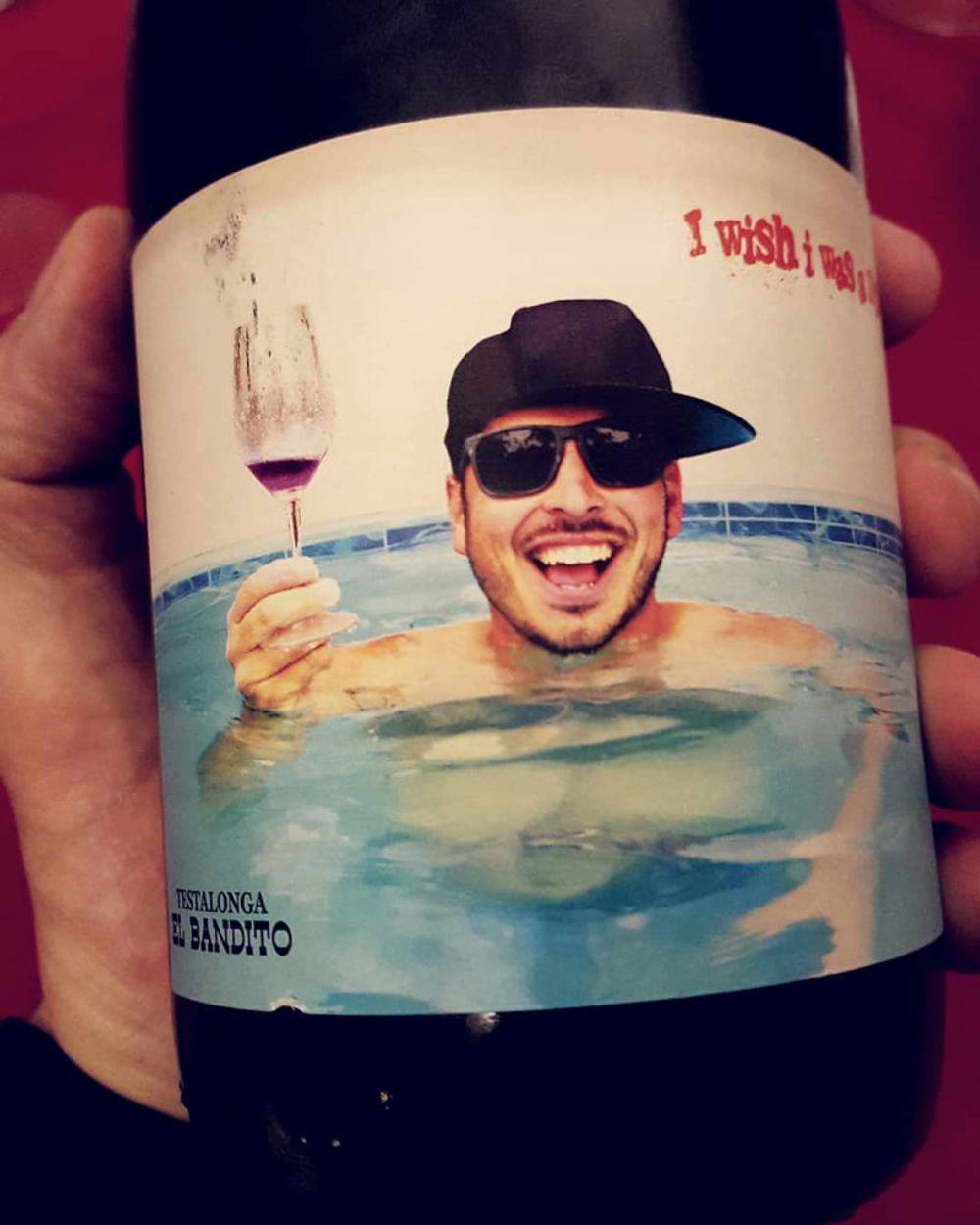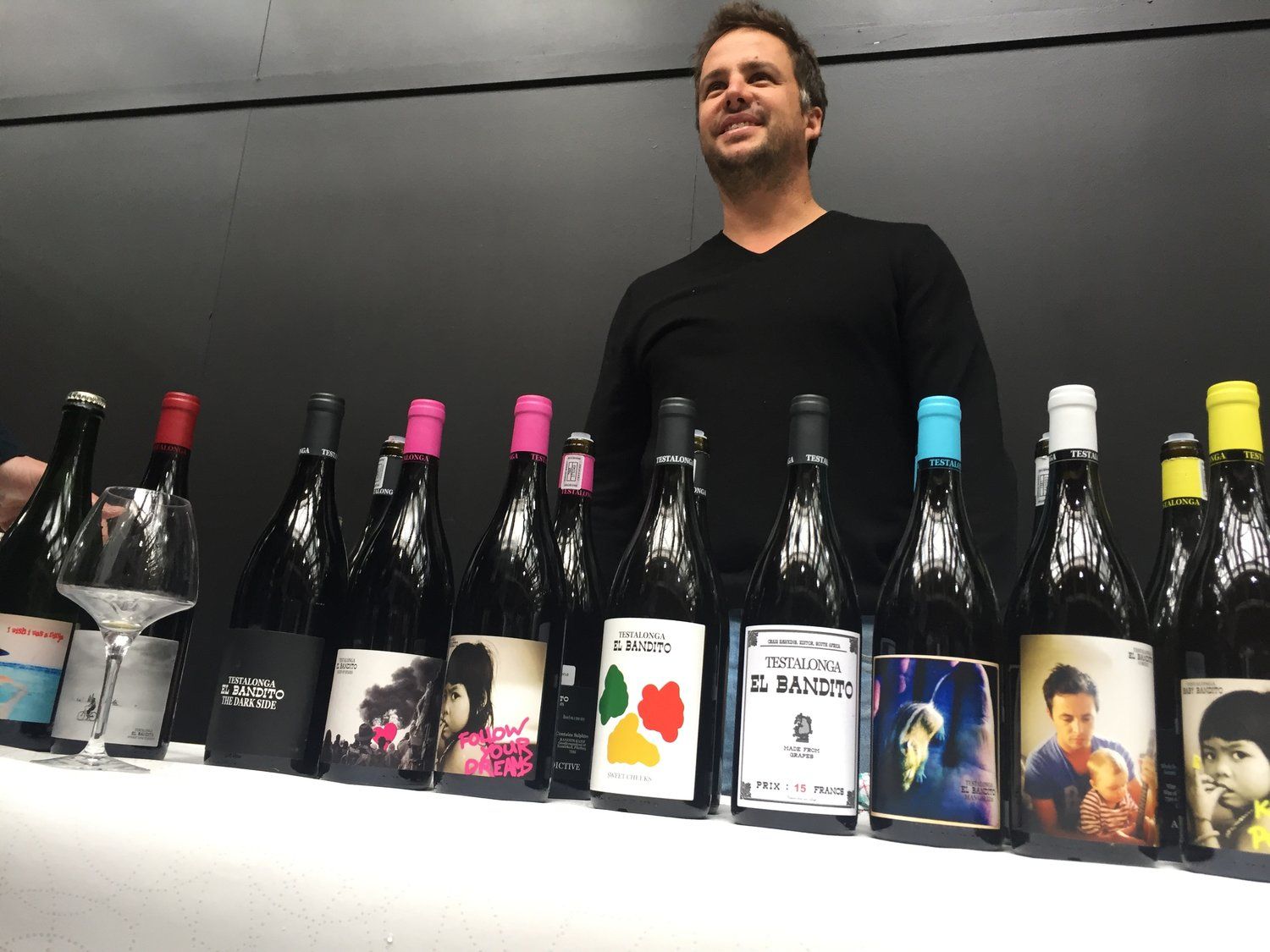Hawkins is happy with the 2019 vintage, with all the wines expressing enhanced texture. There was (finally) rain but the cool temperatures meant that everything ripened all at once which kept everyone at Testalonga on their toes.

Craig Hawkins: keen to avoid stereotypes
Call Craig Hawkins of Testalonga the ‘Natural Wine King of South Africa’, and he’ll shrug it off. He never asked for that mantle. He simply makes wines the way he wants to. This means only working with organic vineyards and in the cellar, no added yeast, acid or tannin – nothing except small amounts of SO2 if the need calls for it and, it stands to reason, no fining or filtration.
This Durban-born winemaker is all about avoiding stereotypes, an ideology embodied in his self-designed wine labels. They are all constructed from various photos that have appealed to him in some way – elicited an emotion, made him smile – from a field mouse he cradled in his hand (El Bandito Mangaliza 2019); to the childlike red, green and yellow splotches on El Bandito Sweet Cheeks 2019, which are an homage to the kids that come into the vineyards and eat the sweet Muscat d’Alexandrie, colloquially known as hanepoot.
Craig and Carla have just released the 2019s. I get to taste them on a windswept Monday morning in Cape Town, while others are headed towards spreadsheets. Craig is presenting his two separate Testalonga ranges: ‘El Bandito’ and ‘Baby Bandito’ at Wine Cellar in Observatory.

Craig on the sorting table for the 2019 vintage
“My idea of terroir is simple, single grape, single soil,” says Craig. The grapes come from organically farmed vineyards in the Paardeberg (11ha, planted on granitic soils) as well as in the Piketberg (4ha, planted on sandstone). In 2015 Craig and Carla purchased a farm in the northern mountains of the Swartland, and have called it Bandit’s Kloof; there they are focusing on Mediterranean grape varieties. The first vineyards were planted in 2018.
“I am very happy with the vintage,” says Craig, his wines lined up behind him, like a row of psychedelic soldiers. “We had good rains beforehand, which meant ripening was very even. The wines have this great texture. Though it was still a very tricky vintage as the ripening happened all at once due to the cooler harvest and cool nights, which meant, with there being more water in the soil, the grapes ripened quickly—it kept us on our toes.”

We start with the Baby Bandito Keep on Punching 2019. “I choose my picking times on acidity,” he shares. “Acid is the backbone of our wines, the key to what we do. Then, the old vines we use bring balance, and yes, sunshine gives the wines a richness.”
The Chenin for this wine was planted in 1961, dryland bush vines (un-trellised), a 4ha block of Chenin planted on the sandstone soils of the Piketberg foothills. “It’s our oldest block of Chenin vines, and a river runs through it – it was a good movie too,” Craig laughs. “The river provides enough water throughout the long, hot summer for it to thrive.”
Keep on Punching was fermented and matured in a combination of foudre and stainless steel tanks. Like the river that gives it life, it runs in lines of freshness and stoniness; layered with bright, sunshiny fruit: appley and peachy, with a savoury, bay leaf-like undertow.

Like all good things in life, there’s humour and whimsy about the wines. The so-named El Bandito Lords of Dogtown 2019 has a sepia photo of farm animals on the label. “Carla took the photo one morning of our donkeys and some cattle, and they really do look like Lords. It’s on our new farm, which is pretty rough at the moment, so we called it Dogtown, and they are definitely the Lords of Dogtown,” explains Craig with a smile.
The 100 per cent Chenin is made from just 13 rows of bush vine. Planted in 1981, the vineyard was previously abandoned. “It’s the third year we have been resurrecting it. We pruned it and skoffeled [to clean around the vine by hand] and did not sucker. Even though we had more rain this year than previous, the vines still struggled along and didn’t give a big yield, but we’re happy with the quality.”
A bloom of warm apricot makes the wine heady, a pleasing contrast against its piercing acidity. A substratum down is the mineral deposit, a line of salt, stitching its way through the wine.
Craig pulls the cork out of the El Bandito Cortez 2019; its cool, black-and-white label a moment of punctuation in the line-up. “For me this is probably the Chenin that has the most complexity and longevity.”
“The vineyard, planted in 1972, is a special one as it has been farmed organically since 2001 and every year, good or bad, gives a tension we sometimes don’t find in our other wines [as much]. This, I think, is due to the high percentage of quartz in the soil.”
The wine is also an exercise on when to bring oxygen into a wine and when not to. When working as minimally in the cellar as the Hawkins do, this, along with picking for acidity as well as vineyard selection, is the key to their inimitable wines.
The wine was fermented and aged in 500L old French foudre and a single 1500L stainless steel tank for six months, then blended together and placed back into wood and stainless steel. It’s focused and precise; with sage, flint, ethereal white pear; it manages to be weightless but also full of depth, like plunging into a pool.

A tour de force is the Baby Bandito Stay Brave 2019. “Planted in 1981, this is a 1.5ha block, which was abandoned in 2014, we approached the farmer and asked if we could try and revive it. The vineyard gives a very specific, salty character to the wines, maybe not as intense as those from the heart of the Paardeberg but there is a definite salinity, which we love.”
Next up is the El Bandito Mangaliza 2019 (the one of field mouse fame). Made from 100% Harslevelü. “This grape handles the Swartland heat,” states Craig. Salty, wild grapefruit joins pithy naartjie, with an edge of spice on the finish.
“Now we come to where it all started,” he says. The El Bandito Skin was first wine to be made under the Testalonga label, and immediately shot Craig to fame (or is it infamy?). The 2019 is made with grapes from 1972 Paardeberg bush vine Chenin, planted on granite. It was fermented on the skins for eight days before being pressed into one 3000L foudre. Nosing my glass my first thought is of steaming jasmine tea, orange blossom quickly follows; with sea breeze and waxy honeycomb: the aromatics are nuanced, and they pull you in like line-drawn arrows to the textured, chalky palate.
“The El Bandito Sweet Cheeks 2019 is where I learnt that skin contact can also be used to lift a wine, and not just used for texture.” 100% Muscat d’Alexandrie (bush vines, planted in 1952) was left on the skins for 10 days and matured in 500L old oak casks. It’s fleshy and juicy with a serious edge of dried herbs. There’s a tautness, which keeps the grape’s natural exuberance nipped and neatly tucked.
Onto the reds, the Baby Bandito Follow Your Dreams 2019 is first up. “I’m happy with the reds this year,” says Craig. “There’s good fruit ripeness.” Follow Your Dreams is 100% Carignan from bush vines planted in 2001. Raw nuts and white pepper join a plethora of red fruit: pomegranate, cranberry, cherry – all sliding into a silky smooth, sappy palate.
Testalonga is the only producer in the Swartland making a 100% Tinta Amarela, the El Bandito Queen of Spades 2019. It’s idiosyncratic with loads of funk and verve, though is light-bodied enough to get away with it. Packing concentrated red and black fruits, with the wild scent of coastal scrub, it’s fresh on the palate with good tannic grip.
If the Queen of Spades is a kaleidoscope, then the El Bandito The Dark Side 2019 is its shadow world – darkly floral: violets and white pepper sail on a sea of crunchy red fruit. Slippery tannins and pure, precise fruit seam together effortlessly with a ferricrete finish.
“This is a grape I’m going to explore a lot more in the future,” shares Craig talking about the El Bandito Monkey Gone to Heaven 2019, made from 100% Mourvedre. “It’s like a tea, the longer you let it brew, the more it develops, but you have to know when to call it.” It was whole bunch fermented for nine days in open tanks, after which it was pressed and aged in three 500L French barrels. Concise, clear and full of intrinsic energy, this wine walks the line between the natural wildness of the cultivar and purity of its fruit expression.

A refreshing end to the tasting are Craig’s pet-nats: the El Bandito ‘I Am The Ninja 2019’ and the El Bandito ‘I Wish I Was A Ninja 2019’. “They’re the greatest joy to make. They’re also the most technical,” he shares. Naturally sparkling, the grapes were fermented in fibreglass tanks and racked a number of times during fermentation to remove the sediment. They were then bottled under crown cap and left to finish fermentation to build up a natural pressure of carbon dioxide. After 10 months the bottles were riddled, disgorged and topped with the same wine (from other decanted bottles) and crown capped again.
The differences between the Ninjas are the cultivars; I Am The Ninja is made with Chenin (planted in 1961), while I Wish I Was A Ninja is Colombard (planted in 1998). They were also bottled at different residual sugars.
The pet-nats are all about the tension between the acid and sugar, and Craig pulls that line tight. They’re not just a joy to make, but also to drink.
As are all of Testalonga’s wines – there is a distinct quest for purity, yes, but there’s also an insatiable, authentic desire to have some fun, which is a quality all good bandits seem to have.
Award-winning wine writer, Malu Lambert won the title of Emerging Wine Writer of the Year at Louis Roederer International Wine Writers’ Awards 2019. She also won the Veritas Young Wine Writer in 2015.

She writes for numerous titles, including Food & Home, Good Taste, Winemag.co.za, WOSA, Winelands, wine.co.za and more. Malu is currently a WSET Diploma student. She is also a graduate of the Michael Fridjhon Wine Judging Academy. The rest of the time she runs, FABLE: a story-telling, social media and copywriting company. Follow her on @MaluLambert
































